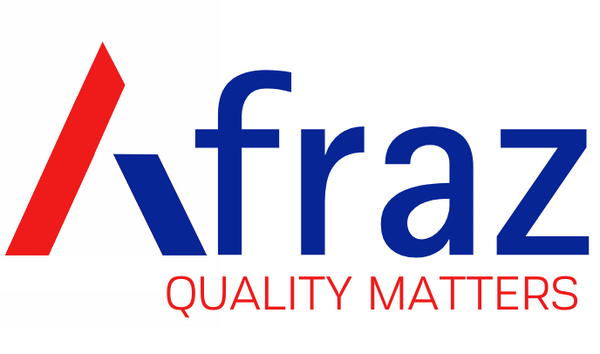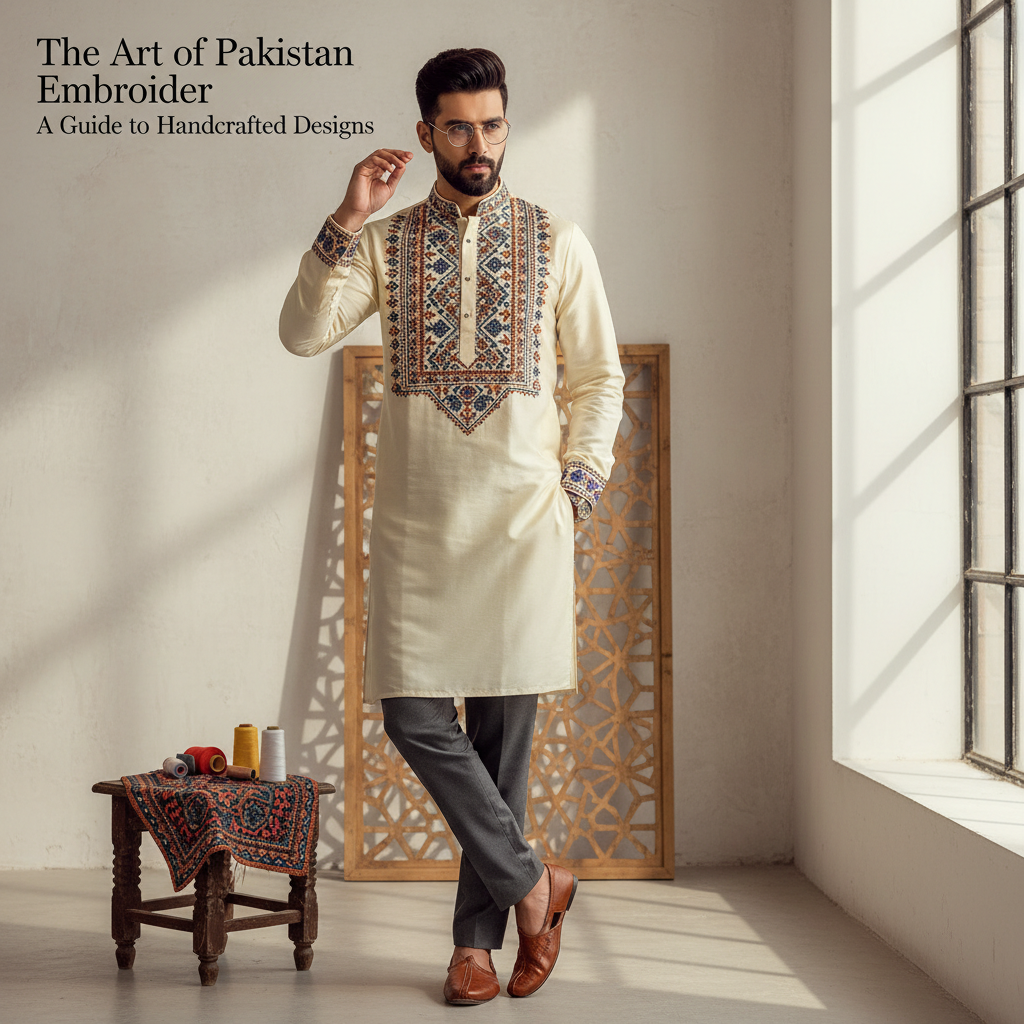A Legacy Stitched in Time: The Soul of Pakistani Craftsmanship
In the vibrant tapestry of global fashion, few traditions shine as brightly as Pakistani embroidery. More than just decorative stitching, it's a narrative woven with threads of history, culture, and identity. Each pattern, each motif, and each color choice tells a story passed down through generations. For the modern man, embracing garments with this artistry is not just a style statement; it's a connection to a profound legacy of craftsmanship. At AFRAZ, we believe in celebrating this heritage, bringing you pieces that are both timeless and contemporary.
From the bustling markets of Lahore to the serene villages of Sindh, artisans have been perfecting these techniques for centuries. The embroidery of Pakistan is a diverse and intricate world, a testament to the region's rich history as a crossroads of civilizations—Mughal, Persian, and Central Asian influences have all left their indelible mark. Today, these ancient crafts are finding new life in modern menswear, adorning everything from kurtas and waistcoats to shawls and sherwanis, offering a unique blend of elegance and cultural pride.

The Diverse Palette: Iconic Embroidery Styles of Pakistan
To truly appreciate the art, one must understand its diverse forms. Pakistani embroidery is not a monolith; it's a collection of regional specialties, each with its unique character and technique. Let's delve into some of the most celebrated styles that continue to captivate designers and fashion connoisseurs alike.
Phulkari and Kantha: A Shared Subcontinental Heritage
While often associated with specific regions, the beauty of textile arts like Phulkari and Kantha lies in their shared heritage across the subcontinent. Phulkari, which literally translates to 'flower work', originates from the Punjab region, an area that historically spans both modern-day India and Pakistan. This technique is characterized by its use of darn stitches on the reverse side of the cloth, creating a stunning, dense pattern on the front. The threads, typically vibrant silk floss, cover the coarse cotton base in geometric or floral motifs.

Similarly, Kantha, a running stitch originating from the Bengal region, has found its way into the broader lexicon of South Asian fashion. Known for its simplicity and narrative quality, Kantha stitching often tells stories through its patterns. When these two worlds collide, the result is breathtaking. An accessory like an Indian Traditional Dupatta with Kantha Silk Phulkari is a perfect example of this cross-pollination of artistry. While labeled a dupatta, it can be styled magnificently as a men's shawl or scarf, adding a powerful splash of color and intricate texture to a simple kurta or sherwani. It represents a celebration of craftsmanship that transcends borders, a piece of wearable art for any discerning gentleman.
Shisha or Mirror Work: Reflecting Tradition
Originating from the desert regions of Sindh and Balochistan, Shisha work is one of the most recognizable forms of Pakistani embroidery. Small, reflective pieces of mirror (shisha) are intricately embroidered onto fabric, creating a dazzling effect that catches the light with every movement. This technique was traditionally believed to ward off the evil eye. In contemporary men's fashion, Shisha work adds a touch of festive brilliance to waistcoats, kurta collars, and cuffs, making it a popular choice for weddings and celebrations.

Zardozi: The Royal Embellishment
If there is one embroidery style synonymous with royalty, it is Zardozi. This opulent art form, with its roots in Persia, flourished under the patronage of the Mughal emperors. Zardozi involves the use of real gold and silver threads, along with pearls and precious stones, to create lavish, three-dimensional patterns. The process is painstaking, requiring immense skill as artisans use needles and hooks to couch the metallic threads onto a base of silk or velvet.
Today, Zardozi remains the pinnacle of luxury in men's formal wear. A Zardozi-adorned sherwani or prince coat is a statement of unparalleled elegance and sophistication, often reserved for the most important occasions, like a groom's wedding attire. While modern artisans often use synthetic metallic threads for accessibility, the grandeur and meticulous technique remain unchanged.

Chawal Sitara: The Subtle Sparkle
For those who appreciate a more understated form of glamour, Chawal Sitara work is a perfect choice. This delicate technique involves sewing tiny, star-shaped sequins (sitara) onto fabric, often interspersed with small beads or 'chawal' (rice) shaped elements. The result is a subtle shimmer that adds depth and texture without being overwhelming. It’s about creating a gentle play of light, a sophisticated sparkle that enhances the base fabric rather than dominating it.
This style is incredibly versatile, lending itself beautifully to both formal and semi-formal menswear. It brings a refined elegance to kurtas, allowing them to transition seamlessly from day to evening events. A prime example of this craft's modern appeal is the 2PC Net with Handmade Chawal Sitara Embroidery. This ensemble masterfully utilizes the technique on a contemporary net fabric, creating a look that is both rooted in tradition and perfectly suited for the modern man. The handmade nature of the embroidery ensures that each sequin is placed with precision, showcasing the artisan's dedication.

Integrating Handcrafted Embroidery into Your Wardrobe
Embracing embroidered pieces doesn't mean you have to overhaul your entire style. The key is balance and thoughtful integration.
- Start with Accessories: A Phulkari or Kantha-stitched shawl, as mentioned earlier, is an excellent entry point. It can elevate a plain monochromatic outfit instantly.
- Focus on Details: Opt for a kurta with subtle embroidery on the collar, placket, and cuffs. This adds a point of interest without being too loud for casual or semi-formal settings.
- Embrace the Waistcoat: An embroidered waistcoat is perhaps the most versatile piece a man can own. Wear it over a simple kurta-pajama set to instantly make it formal, or even pair it with a crisp button-down shirt and trousers for a fusion look.
- Go Bold for Occasions: For weddings and major festivities, don't be afraid to choose a fully embroidered piece. A Zardozi sherwani or a Chawal Sitara kurta set is designed for celebration and allows you to fully express your appreciation for the craft.
The Future of a Timeless Craft
In an age of fast fashion and mass production, the value of handcrafted embroidery is more significant than ever. Each piece is a testament to the artisan's skill, patience, and artistic vision. By choosing to wear and invest in these garments, you are not just acquiring a piece of clothing; you are becoming a patron of the arts. You are helping to sustain a centuries-old tradition and supporting the skilled artisans who are the true custodians of this incredible heritage.
At AFRAZ, our collection is a curated celebration of this art form. We invite you to explore the intricate details, feel the texture of the threads, and wear a piece of history. Discover the art of Pakistani embroidery and let your style tell a story of timeless elegance and cultural pride.

